Using Deficit Irrigation Strategies and Adding Sugarcane Waste Biochar as a Sustainable Material to Sandy Soils for Improving Yield and Water Productivity of Cucumber
Abstract
1. Introduction
2. Methodology
Evaluation Parameters
3. Results and Discussion
3.1. BJH, BET, and Isotherms
3.2. Soil Moisture and Water Stress in the Rhizosphere
3.3. Water Application Efficiency
3.4. Yield of Cucumber
3.5. Water Productivity
3.6. Quality Traits of Cucumber
4. Conclusions
Author Contributions
Funding
Institutional Review Board Statement
Informed Consent Statement
Data Availability Statement
Acknowledgments
Conflicts of Interest
References
- Abdelraouf, R.E.; Okasha, E.M.; Tarabye, H.H.H. Modified Design for Drip Irrigation System to Improve the Productivity of Irrigation Water and Fertilizers Distribution. Int. J. ChemTech Res. 2016, 9, 40–52. Available online: http://www.sphinxsai.com/2016/ch_vol9_no9/1/(40-52)V9N9CT.pdf (accessed on 1 January 2020).
- Bakari, R.; Kivevele, T.; Huang, X.; Jande, Y.A.C. Simulation and optimisation of the pyrolysis of rice husk: Preliminary assessment for gasification applications. J. Anal. Appl. Pyrolysis 2020, 150, 104891. [Google Scholar] [CrossRef]
- Okasha, E.M.; Abdelraouf, R.E.; Abdou, M.A.A. Effect of Land Leveling and Water Applied Methods on Yield and Irrigation Water Use Efficiency of Maize (Zea mays L.) Grown under Clay Soil Conditions. World Appl. Sci. J. 2013, 27, 183–190. [Google Scholar]
- Hafez, M.; Sally, F.; Abo El-Ezz Popov, A.I.; Rashad, M. Organic Amendments Combined with Plant Growth-Promoting Rhizobacteria (Azospirillum brasilense) as an Eco-Friendly By-Product to Remediate and Enhance the Fertility of Saline Sodic-Soils in Egypt. Commun. Soil Sci. Plant Anal. 2021, 52, 1416–1433. [Google Scholar] [CrossRef]
- Adeyemi, O.; Keshavarz-Afshar, R.; Jahanzad, E.; Battaglia, M.L.; Luo, Y.; Sadeghpour, A. Effect of wheat cover crop and split nitrogen application on corn yield and nitrogen use efficiency. Agronomy 2020, 10, 1081. [Google Scholar] [CrossRef]
- Adnan, M.; Fahad, S.; Zamin, M.; Shah, S.; Mian, I.A.; Danish, S.; Zafar-ul-Hye, M.; Battaglia, M.L.; Naz, R.M.M.; Saeed, B.; et al. Coupling phosphate-solubilizing bacteria with phosphorus supplements improve maize phosphorus acquisition and growth under lime induced salinity stress. Plants 2020, 9, 900. [Google Scholar] [CrossRef] [PubMed]
- Diatta, A.A.; Fike, J.H.; Battaglia, M.L.; Galbraith, J.; Baig, M.B. Effects of biochar on soil fertility and crop productivity in arid regions: A review. Arab. J. Geosci. 2020, 13, 595. [Google Scholar] [CrossRef]
- Diatta, A.A.; Thomason, W.E.; Abaye, O.; Thompson, T.L.; Battaglia, M.L.; Vaughan, L.J.; Lo, M.; Leme, J.F.D.C. Assessment of nitrogen fixation by mungbean genotypes in different soil textures using 15N natural abundance method. J. Soil Sci. Plant Nutr. 2020, 20, 2230–2240. [Google Scholar] [CrossRef]
- Robertson, J. Diamond-like amorphous carbon. Mater. Sci. Eng. R Rep. 2002, 37, 129–281. [Google Scholar] [CrossRef]
- Seleiman, M.F.; Almutairi, K.F.; Alotaibi, M.; Shami, A.; Alhammad, B.A.; Battaglia, M.L. Nano fertilization as an emerging fertilization technique: Why modern agriculture can benefit from its use? Plants 2021, 10, 2. [Google Scholar] [CrossRef]
- Seleiman, M.F.; Alotaibi, M.A.; Alhammad, B.A.; Alharbi, B.M.; Refay, Y.; Badawy, S.A. Effects of ZnO nanoparticles and biochar of rice straw and cow manure on characteristics of contaminated soil and sunflower productivity, oil quality, and heavy metals uptake. Agronomy 2020, 10, 790. [Google Scholar] [CrossRef]
- Seleiman, M.F.; Kheir, A.M.S. Maize productivity, heavy metals uptake and their availability in contaminated clay and sandy alkaline soils as affected by inorganic and organic amendments. Chemosphere 2018, 204, 514–522. [Google Scholar] [CrossRef] [PubMed]
- Bhagyawant, R.G.; Gorantiwar, S.D.; Dahiwalkar, S.D. Effect of Deficit Irrigation on Crop Growth, Yield and Quality of Onion under Surface Irrigation. Am.-Eurasian J. Agric. Environ. Sci. 2015, 15, 1672–1678. [Google Scholar]
- Lal, R. Carbon sequestration in dryland ecosystems. Environ. Manag. 2004, 33, 528–544. [Google Scholar] [CrossRef] [PubMed]
- Lehmann, J. Bio-energy in the black. Front. Ecol. Environ. 2003, 5, 381–387. [Google Scholar] [CrossRef]
- Guiller, K.E.; Cádiz, J.; Ehaloitis, C.; Sácala, W.D.; Mafongoya, P.L. Building soil nitrogen capital in Africa. In Replenishing Soil Fertility in Africa; Buresh, R.J., Sanchez, P.A., Eds.; SSSA Special Publication; Soil Science Society of America, Inc.: Madison, WI, USA, 1997; Volume 51, pp. 151–192. [Google Scholar]
- Goyal, S.; Chander, K.; Mundra, M.C.; Kapoor, K.K. Influence of inorganic fertilizers and organic amendments on soil organic matter and soil microbial properties under tropical conditions. Biol. Fertil. Soils 1999, 29, 196–200. [Google Scholar] [CrossRef]
- Gregg, S.J.; Sing, K.S.W. Adsorption, Surface Area and Porosity; Academic: London, UK, 1982. [Google Scholar]
- Abdelraouf, R.E.; Abou-Hussein, S.D.; Abd-Alla, A.M.; Abdallah, E.F. Effect of Short Irrigation Cycles on Soil Moisture Distribution in Root Zone, Fertilizers Use Efficiency and Productivity of Potato in New Reclaimed Lands. J. Appl. Sci. Res. 2012, 8, 3823–3833. Available online: http://www.aensiweb.com/jasr/jasr/2012/3823-3833.pdf (accessed on 1 January 2020).
- Glaser, B.; Lehmann, J.; Zech, W. Ameliorating physical and chemical properties of highly weathered soils in the tropics with charcoal—A review. Biol. Fertil. Soils 2002, 35, 219–230. [Google Scholar] [CrossRef]
- Glaser, B.; Bol, R.; Preedy, N.; McTiernan, K.B.; Clark, M.; Amelung, W. Short term sequestration of slurry-derived carbon and nitrogen in temperate grassland soil using 13C and 15N natural abundance. J. Plant Nutr. Soil Sci. 2001, 164, 467–474. [Google Scholar] [CrossRef]
- Lehmann, J.; Rillig, M.C.; Thies, J.; Masiello, C.A.; Hockaday, W.C.; Crowley, D. Biochar effects on soil biota—A review. Soil Biol. Biochem. 2011, 43, 1812–1836. [Google Scholar] [CrossRef]
- Asai, H.; Samson, B.K.; Stephan, H.M.; Songyikhangsuthor, K.; Homma, K.; Kiyono, Y.; Inoue, Y.; Shiraiwa, T.; Horie, T. Biochar amendment techniques for upland rice production in Northern Laos: 1. Soil physical properties, leaf SPAD and grain yield. Field Crops Res. 2009, 111, 81–84. [Google Scholar] [CrossRef]
- Beesley, L.; Moreno-Jiménez, E.; Gomez-Eyles, J.L.; Hrris, E.; Robinson, B.; Sizmur, T. A review of biochars’ potential role in the remediation, revegetation and restoration of contaminated soils. Environ. Pollut. 2011, 159, 3269–3282. [Google Scholar] [CrossRef] [PubMed]
- Ghorbani, M.; Konvalina, P.; Neugschwandtner, R.W.; Soja, G.; Bárta, J.; Chen, W.; Amirahmadi, E. How do different feedstocks and pyrolysis conditions effectively change biochar modification scenarios? A critical analysis of engineered biochars under H2O2 oxidation. Energy Convers. Manag. 2024, 300, 117924. [Google Scholar] [CrossRef]
- Cabrera, A.; Cox, L.; Spokas, K.A.; Celis, R.; Hermosín, M.C.; Cornejo, J.; Koskinen, W.C. Comparative sorption and leaching study of the herbicides fluometuron and 4-chloro-2 methylphenoxyacetic acid (MCPA) in a soil amended with biochars and other sorbents. J. Agric. Food Chem. 2011, 14, 12550–12560. [Google Scholar] [CrossRef] [PubMed]
- Hafez, M.; Mohamed, E.A.; Rashad, M.; Popov, A.I. The efficiency of application of bacterial and humic preparations to enhance of wheat (Triticum aestivum L.) plant productivity in the arid regions of Egypt. Biotechnol. Rep. 2021, 29, e00584. [Google Scholar] [CrossRef] [PubMed]
- Ramadan, A.R.E.; Ragab, R. Effect of Fertigation Frequency and Duration on Yield and Water Productivity of Wheat: Field and Modelling Study Using the Saltmed Model. Irrig. Drain. 2018, 67, 414–428. [Google Scholar] [CrossRef]
- Ghorbani, M.; Amirahmadi, E.; Konvalina, P.; Moudrý, J.; Bárta, J.; Kopecký, M.; Teodorescu, R.I.; Bucur, R.D. Comparative Influence of Biochar and Zeolite on Soil Hydrological Indices and Growth Characteristics of Corn (Zea mays L.). Water 2022, 14, 3506. [Google Scholar] [CrossRef]
- Hafez, M.; Popov, A.I.; Rashad, M. Influence of Agro-industrial wastes and Azosirillum on Nutrient Status and Grain Yield under Corn plant Growth in Arid Regions. Biosci. Res. 2019, 16, 2119–2130. [Google Scholar]
- Robertson, S.J.; Rutherford, M.P.; López-Gutiérrez, J.C.; Massicotte, H.B. Biochar enhances seedling growth and alters rootvsymbioses and properties of sub-boreal forest soils. Can. J. Soil Sci 2012, 92, 329–340. [Google Scholar] [CrossRef]
- El-Meseery, A.A. Effect of Different Drip Irrigation Systems on Maize Yield in Sandy Soil; John Willey & Sons. Inc.: Chichester, UK, 1988; pp. 152–153, 350–351. [Google Scholar]
- Singh, U. Antinutritional factors of chickpea and pigeonpea and their removal by processing. Plant Foods Hum. Nutr. 1988, 38, 251–261. [Google Scholar] [CrossRef]
- Snedecor, G.W.; Cochran, W.G. Statistical Methods, 7th ed.; Iowa State University Press: Ames, IA, USA, 1980; 593p. [Google Scholar]
- Duncan, D.B. Multiple range and multiple F tests. Biometrics 1955, 11, 1–42. [Google Scholar] [CrossRef]
- Mukherjee, A.; Zimmerman, A. Organic carbon and nutrient release from a range of laboratory-produced biochars and biocharsoil mixtures. Geoderma 2013, 193, 122–130. [Google Scholar] [CrossRef]
- Ghorbani, M.; Amirahmadi, E.; Neugschwandtner, R.W.; Konvalina, P.; Kopecký, M.; Moudrý, J.; Perná, K.; Murindangabo, Y.T. The Impact of Pyrolysis Temperature on Biochar Properties and Its Effects on Soil Hydrological Properties. Sustainability 2022, 14, 14722. [Google Scholar] [CrossRef]
- Ghorbani, M.; Neugschwandtner, R.W.; Konvalina, P.; Asadi, H.; Kopecký, M.; Amirahmadi, E. Comparative effects of biochar and compost applications on water holding capacity and crop yield of rice under evaporation stress: A two-years field study. Paddy Water Env. 2023, 21, 47–58. [Google Scholar] [CrossRef]
- Abdelraouf, R.E.; Ragab, R. The benefit of using drainage water of fish farms for irrigation: Field and modelling study using the SALTMED model. Irrig. Drain. 2017, 66, 758–772. [Google Scholar] [CrossRef]
- Sabra, D.M.; Reda, A.M.; El-Shawy, E.A.; El-Refaee, Y.Z.; Abdelraouf, R.E. Improving barley production under deficient irrigation water and mineral fertilizers conditions. SABRAO J. Breed. Genet. 2023, 55, 211–229. [Google Scholar] [CrossRef]
- Ramadan, A.; Ghanem, H.G.; Bukhari, N.A.; El-Zaidy, M. Field and modeling study on manual and automatic irrigation scheduling under deficit irrigation of greenhouse cucumber. Sustainability 2020, 12, 9819. [Google Scholar] [CrossRef]
- Weber, K.; Quicker, P. Properties of biochar. Fuel 2018, 217, 240–261. [Google Scholar] [CrossRef]
- Association of Official Agricultural Chemists. Official Methods of Analysis, 4th ed; Association of Official Agricultural Chemists: Washington, DC, USA, 1990; pp. 495–510. [Google Scholar]
- Ayarza, M.L.; Raucher, F.; Vilela, L.; Amezquita, E.; Barrios, E.; Rondon, M.; Rao, I. Sustainable intensification of crop-livestock systems on sandy soils of Latin America: Trade-offs between production and conservation. In Proceedings of the Management of Tropical Sandy Soils for Sustainable Agriculture “A Holistic Approach for Sustainable Development of Problem Soils in the Tropics”, Khon Kaen, Thailand, 27 November–2 December 2005; pp. 406–413. [Google Scholar]
- Bakry, A.B.; Ibrahim, O.M.; Abdelraouf, R.E.; Badr, E.A. Effect of Humic Acid, Mycorrhiza Inoculation, and Biochar on Yield and Water Use Efficiency of Flax under Newly Reclaimed Sandy Soil. Agric. Sci. 2014, 5, 1427–1432. [Google Scholar] [CrossRef][Green Version]
- Eid, A.R.; Negm, A. Improving Agricultural Crop Yield and Water Productivity via Sustainable and Engineering Techniques. In Conventional Water Resources and Agriculture in Egypt; The Handbook of Environmental Chemistry; Springer International Publishing AG: Berlin/Heidelberg, Germany, 2019; Volume 74, pp. 561–591. [Google Scholar] [CrossRef]
- Reynolds, J.F.; Stafford Smith, D.M.S. Do humans cause deserts? In Global Desertification: Do Humans Cause Deserts? Reynolds, J.F., Stafford Smith, D.M., Eds.; Dahlem University Press: Berlin, Germany, 2002; pp. 1–21. [Google Scholar]
- Rashad, Y.M.; Hafez, M.; Rashad, M. Diazotrophic Azotobacter salinestris YRNF3: A probable calcite-solubilizing bio-agent for improving the calcareous soil properties. Sci. Rep. 2023, 13, 20621. [Google Scholar] [CrossRef]
- Fekry, W.M.E.; Rashad, Y.M.; Ibrahim, O.M. Modeling the combined effect of fulvic acid, effective microorganisms, and micro-carbon on olive yield. Asian J. Plant Sci. 2023, 22, 394–405. [Google Scholar]

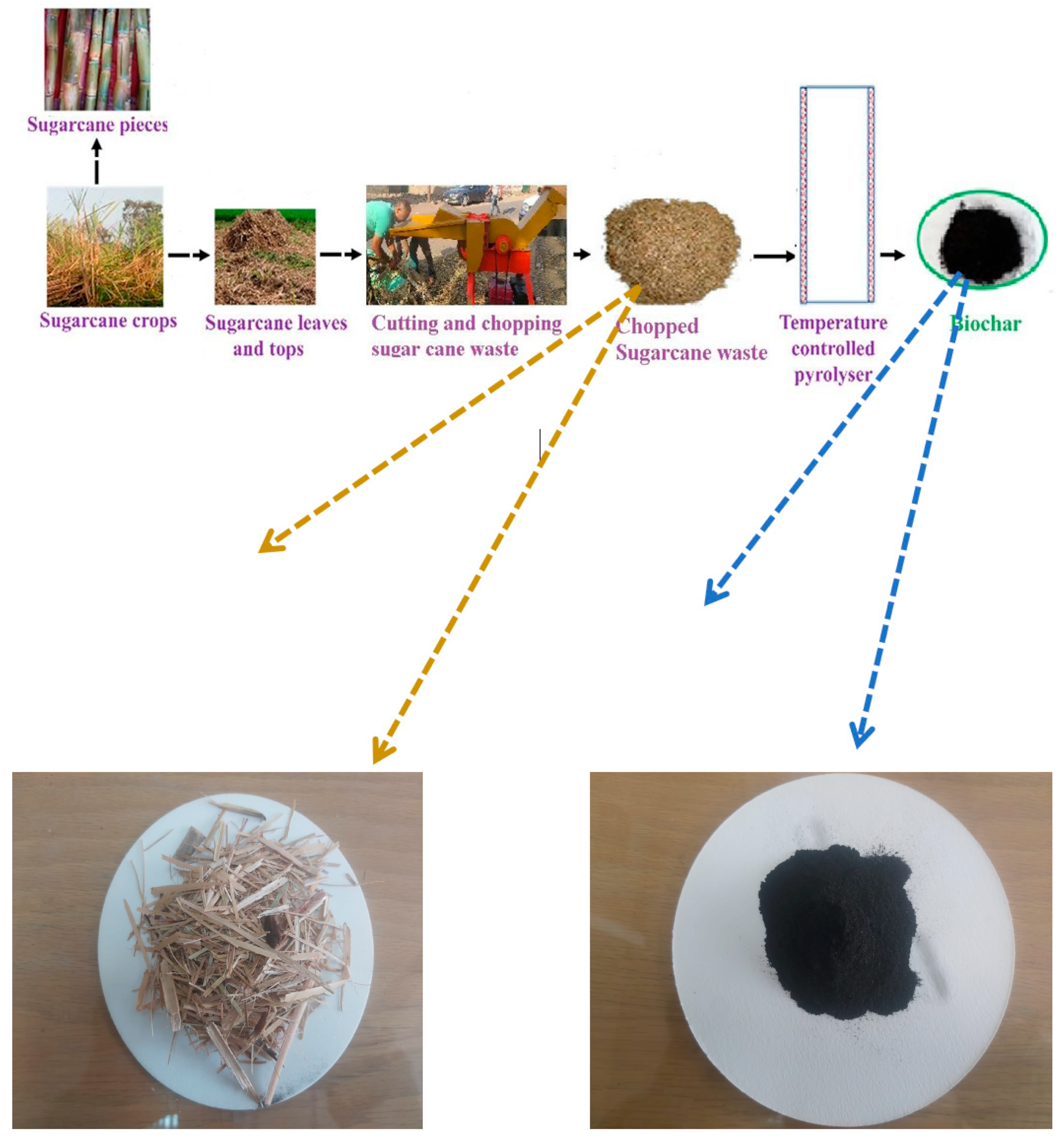
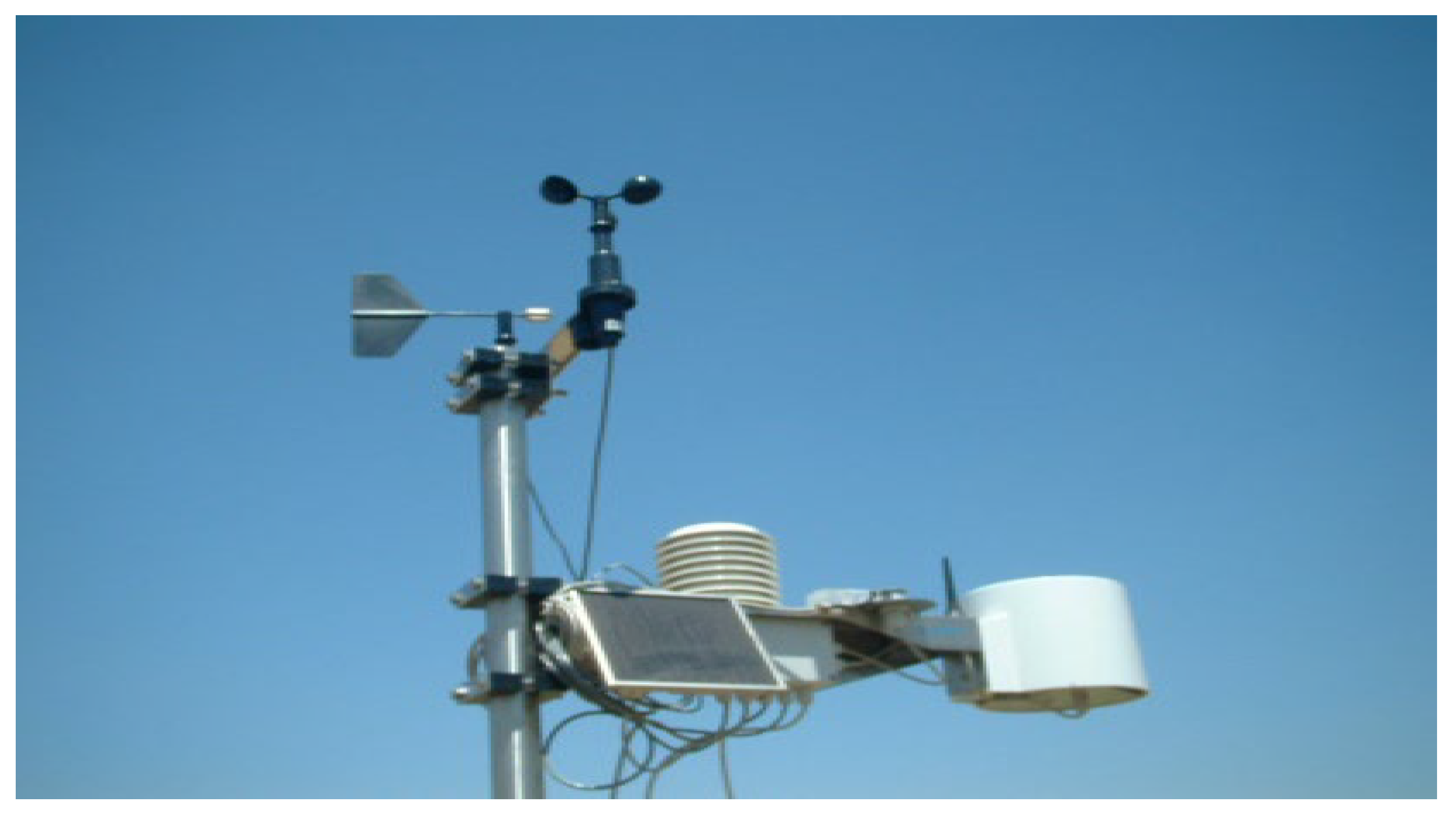
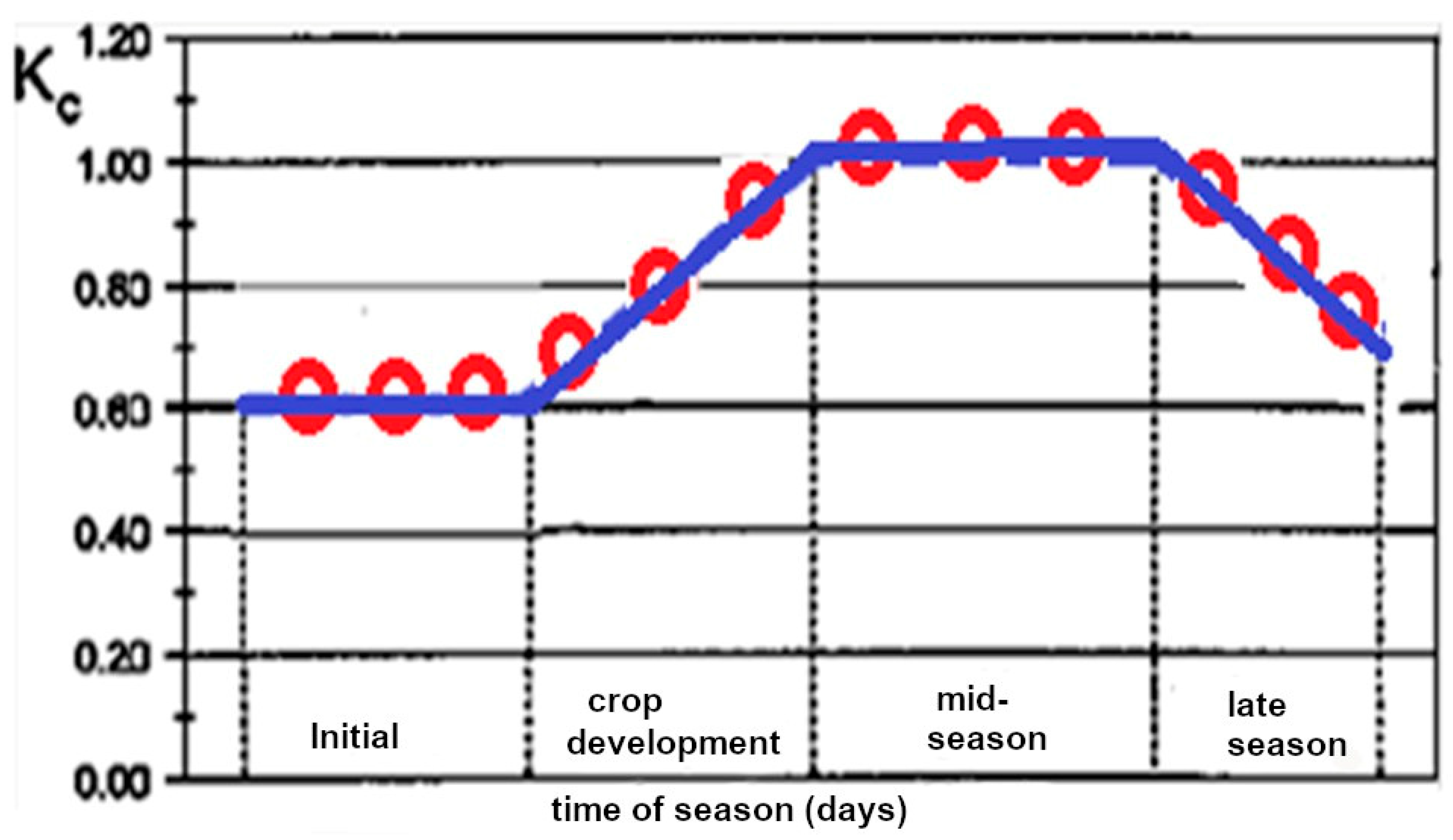

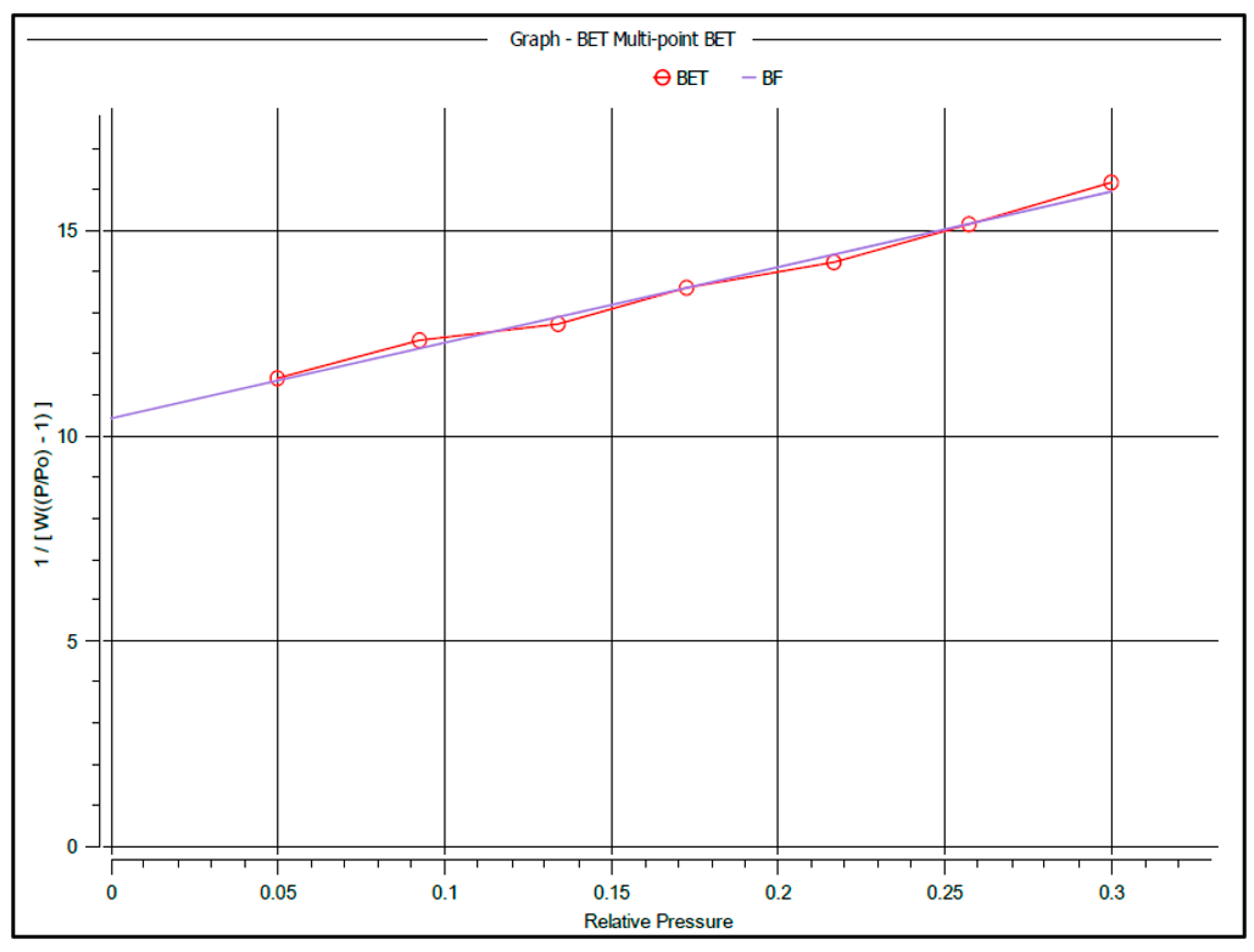
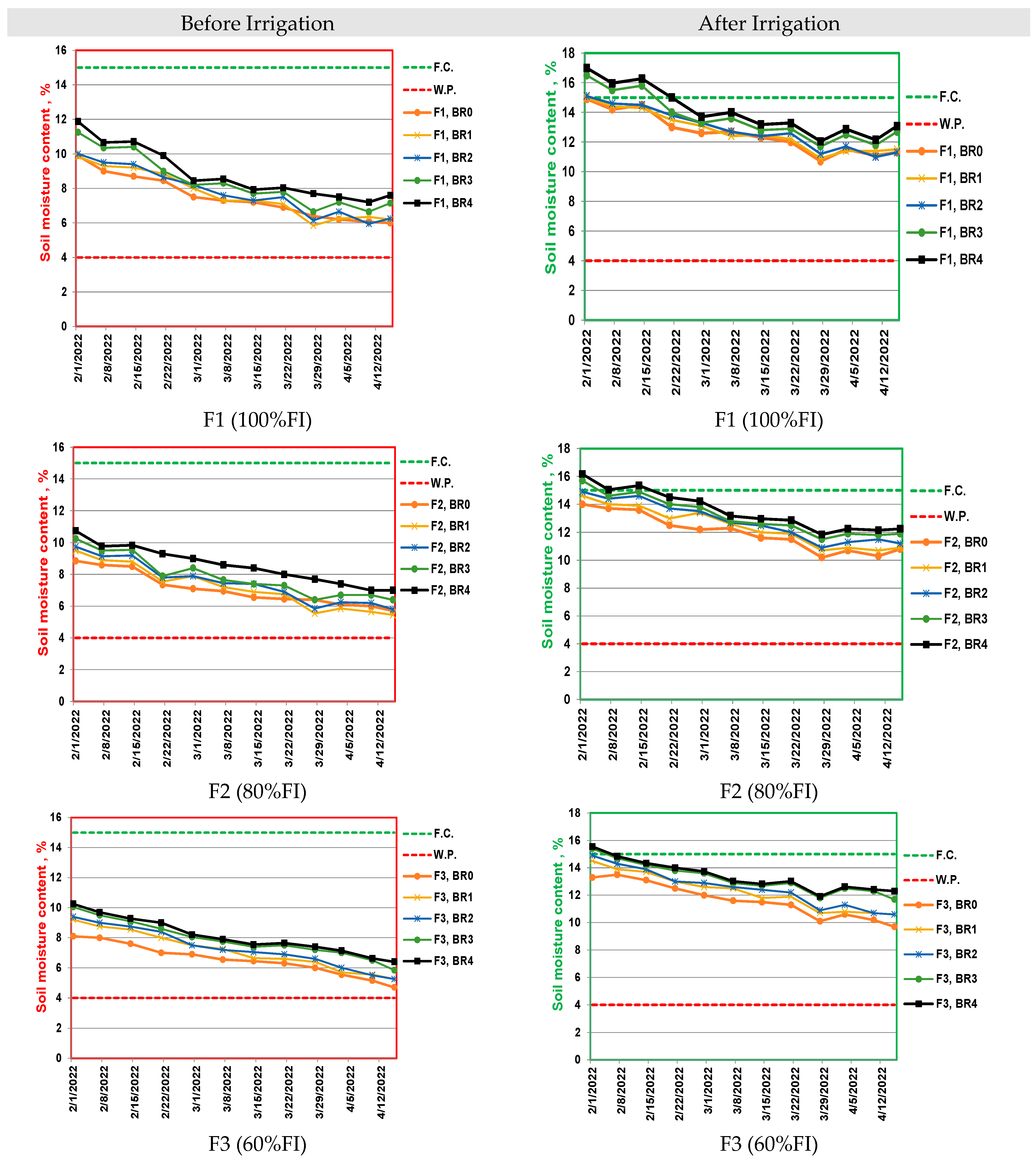
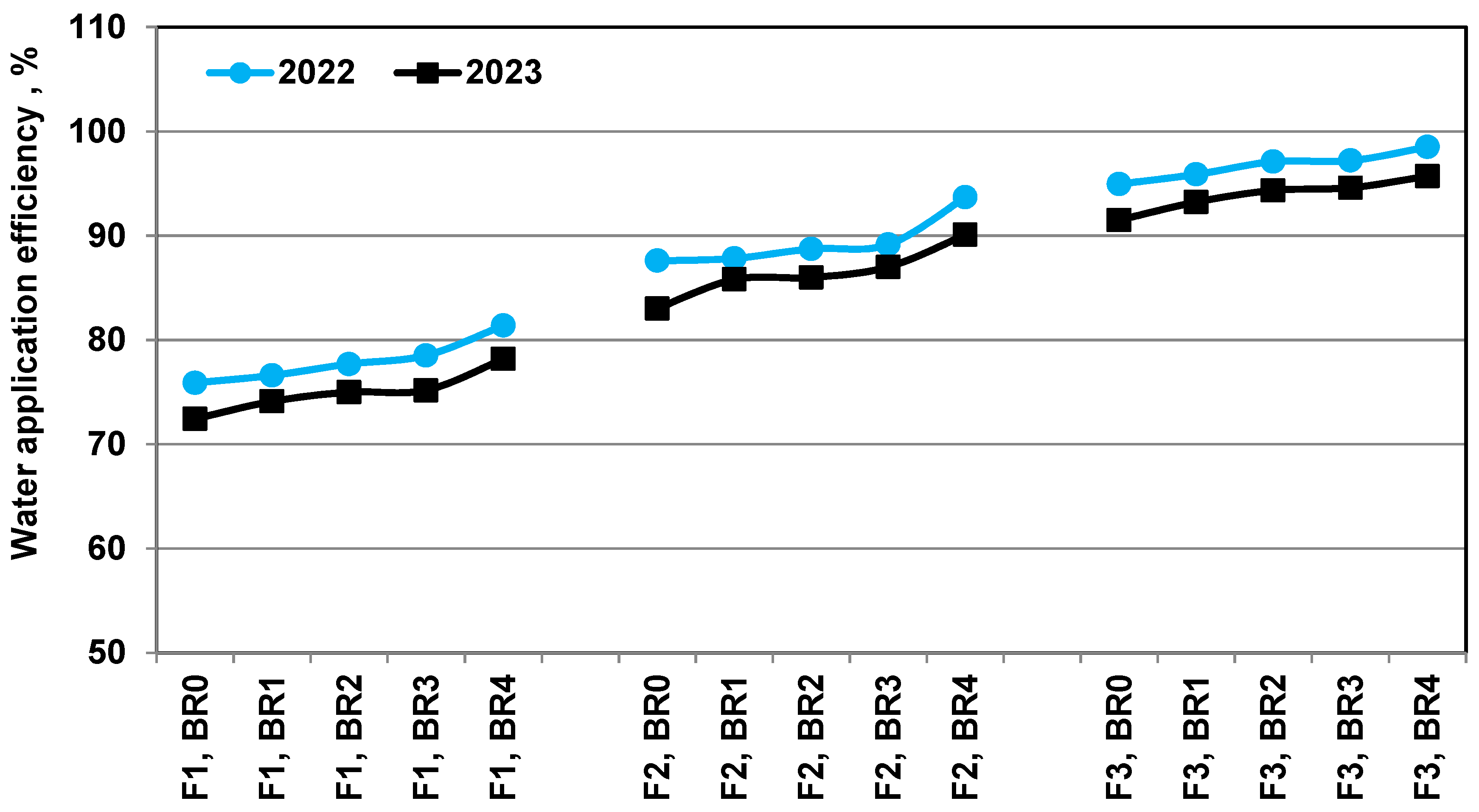
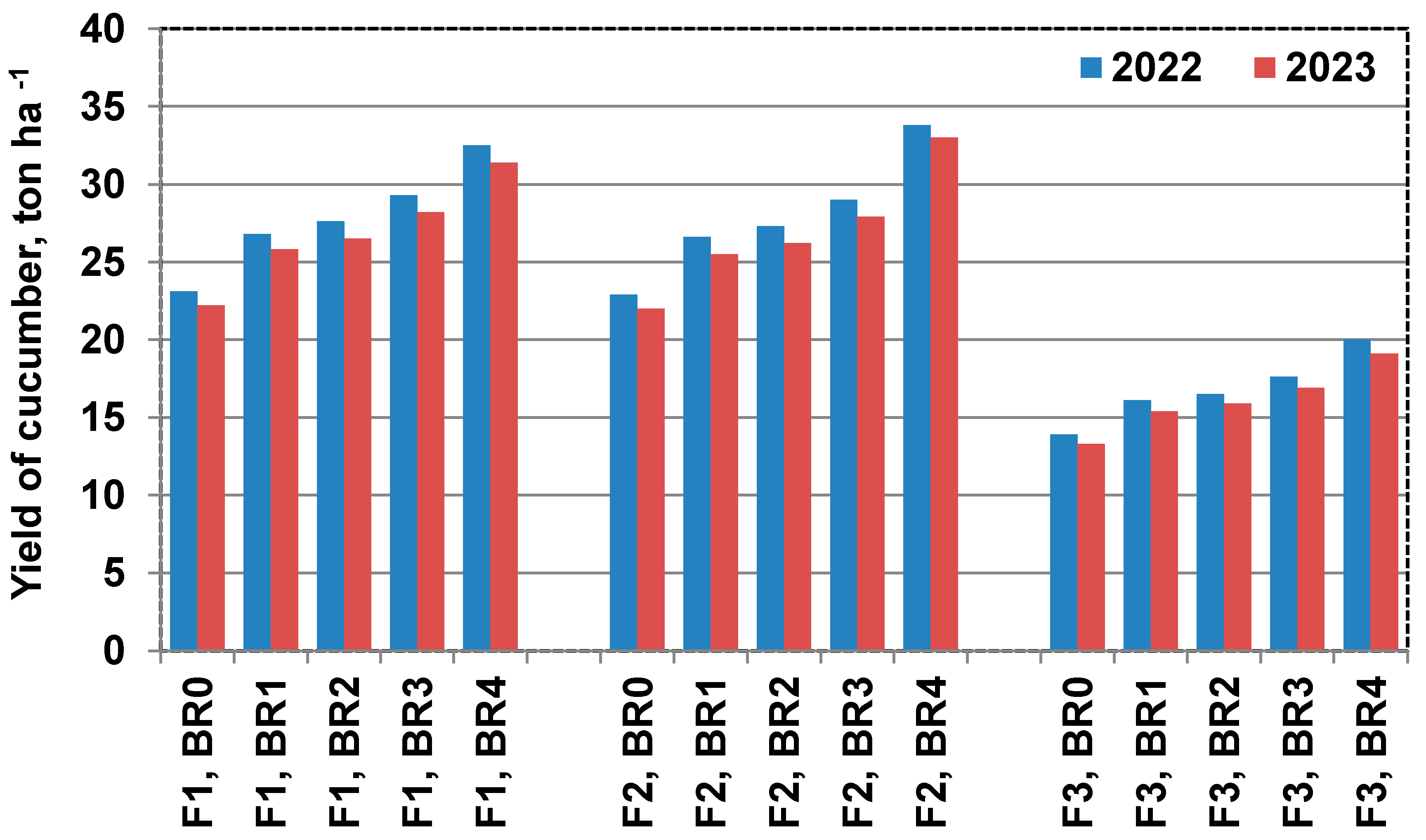
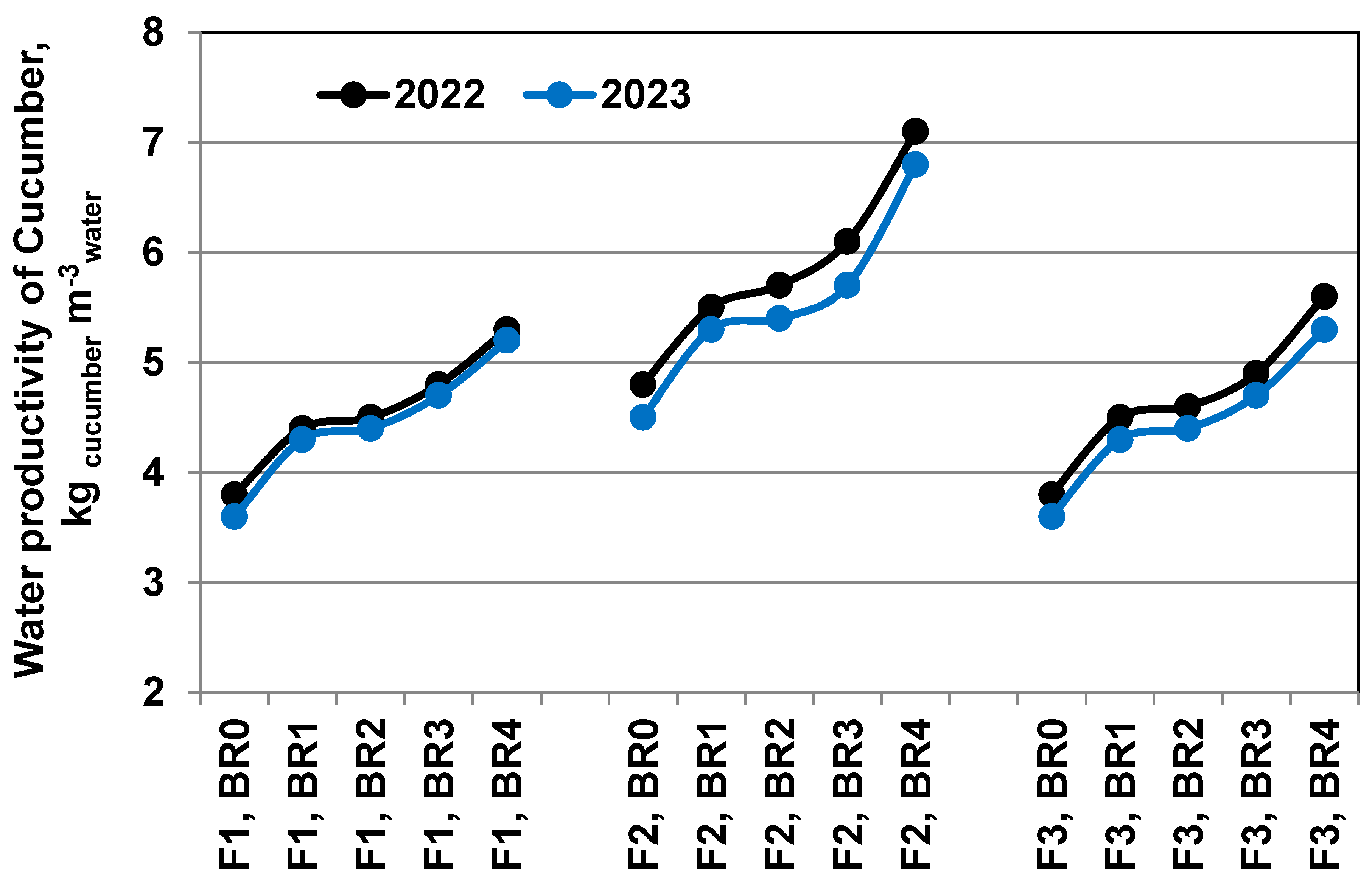

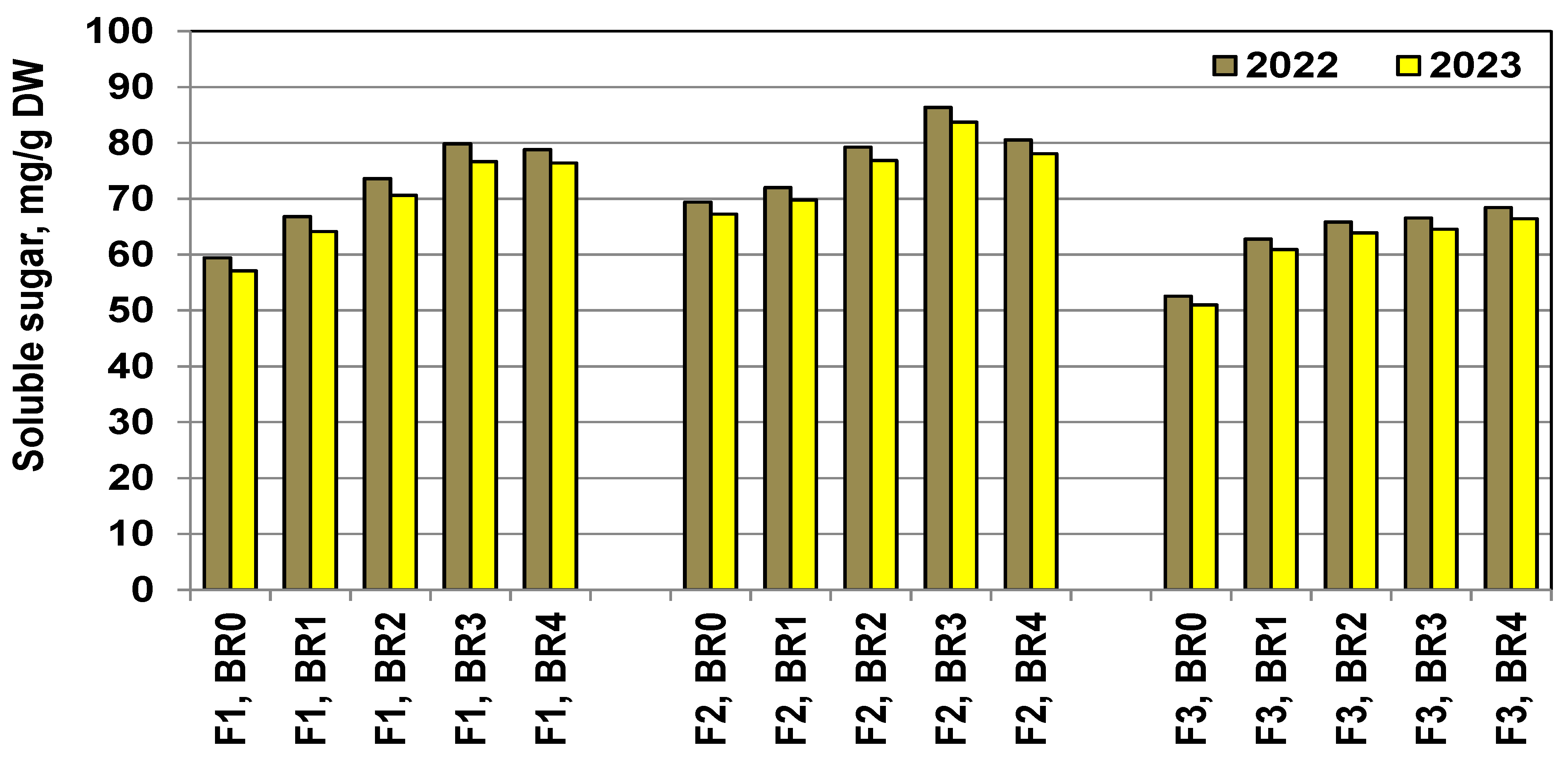
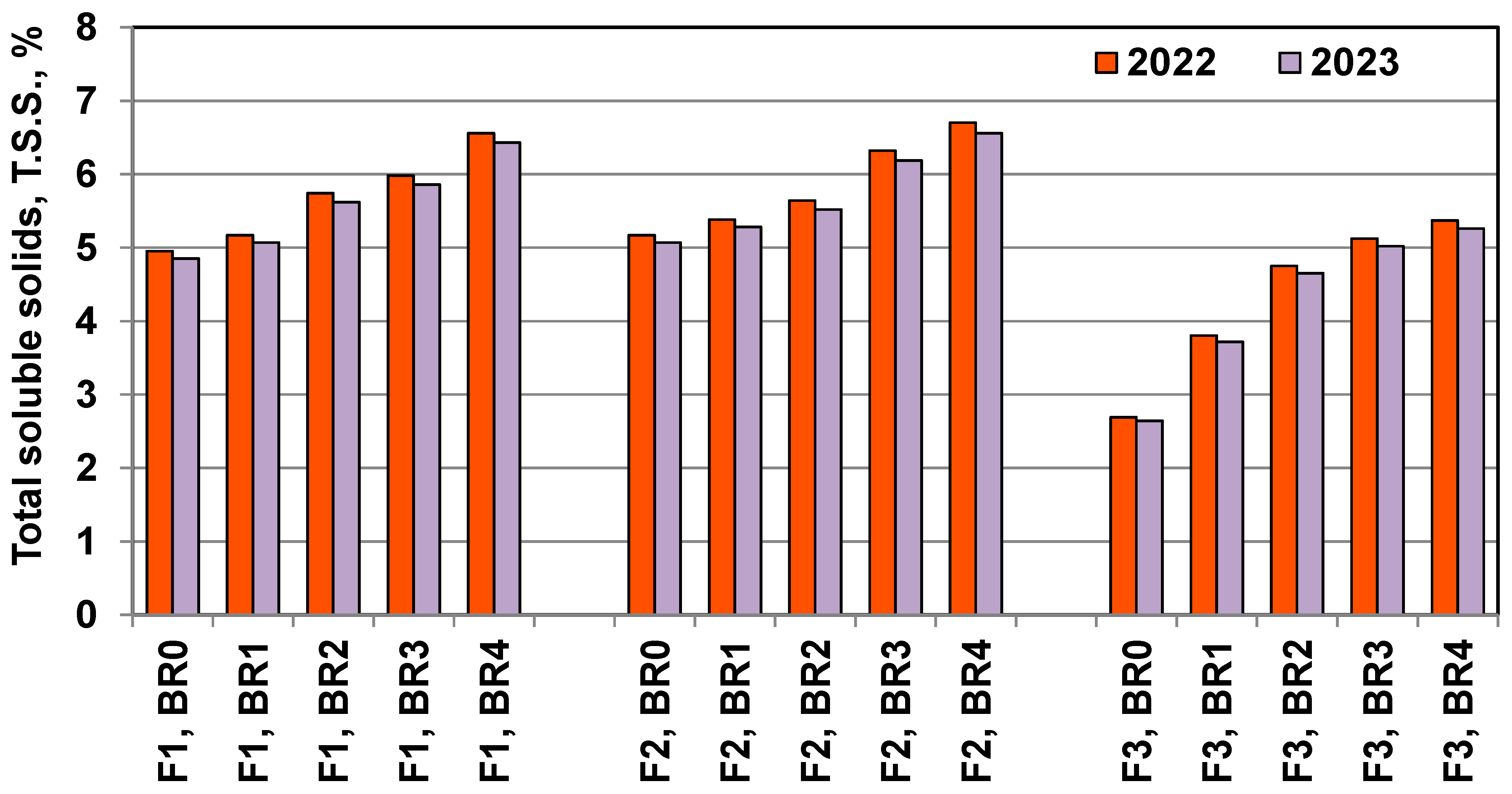
| Climatic Mean Values, 2022 | ||||||||
|---|---|---|---|---|---|---|---|---|
| Months | SRAD | TMAX | TMIN | RAIN | WIND | TDEW | TMean | RH |
| kWh/m2 | °C | mm | m/S | °C | °C | % | ||
| January | 11.40 | 18.82 | 8.70 | 34.48 | 5.33 | 5.95 | 13.07 | 67.83 |
| February | 14.03 | 19.73 | 8.98 | 17.60 | 5.67 | 6.88 | 13.98 | 67.00 |
| March | 17.95 | 21.55 | 10.70 | 9.63 | 6.12 | 7.68 | 15.90 | 61.00 |
| April | 21.04 | 23.2 | 12.62 | 0.00 | 7.14 | 8.94 | 18.74 | 57.11 |
| Climatic mean values, 2023 | ||||||||
| January | 10.92 | 18.84 | 8.74 | 35.51 | 6.00 | 6.00 | 14.00 | 68.13 |
| February | 14.04 | 19.93 | 8.88 | 18.44 | 5.93 | 6.89 | 13.99 | 69.04 |
| March | 18.15 | 20.59 | 11.10 | 9.78 | 6.91 | 7.80 | 16.82 | 62.11 |
| April | 22.32 | 22.95 | 12.41 | 0.00 | 7.54 | 8.85 | 18.09 | 58.05 |
| Deficit Irrigation, m3 | Irrigation Volumes, m3 ha −1 | Biochar Application rates, ton ha.−1 | Symbol | |
|---|---|---|---|---|
| 2022 | 2023 | |||
| F1(100% FI) | 6100 | 6060 | 0 | BR0 |
| F2 (80% FI) | 4800 | 4848 | 5 | BR1 |
| F3 (60% FI) | 3600 | 3636 | 7 | BR2 |
| 9 | BR3 | |||
| 11 | BR4 | |||
| BJH Pore Size Distribution Adsorption Results | ||||||
|---|---|---|---|---|---|---|
| Surface Area: 52.0957 m2/g | ||||||
| Pore Volume: 0.100036 cc/g | ||||||
| Pore Radius Dv(r): 1.92827 nm | ||||||
| Pore Radius | Pore Volume | Pore Surf. (Area) | dv (r) | ds ® | dv (log r) | ds (log r) |
| nm | cc/g | m2/g | cc/nm/g | m2/nm/g | cc/g | m2/g |
| 1.92827 | 1.92 × 10−2 | 1.99 × 101 | 3.74 × 10−2 | 3.88 × 101 | 1.65 × 10−1 | 1.71 × 102 |
| 2.56766 | 3.91 × 10−2 | 3.54 × 101 | 2.59 × 10−2 | 2.02 × 101 | 1.52 × 10−1 | 1.19 × 102 |
| 3.71388 | 5.90 × 10−2 | 4.61 × 100 | 1.31 × 10−2 | 7.04 × 100 | 1.10 × 10−1 | 5.94 × 101 |
| 6.50691 | 7.55 × 10−2 | 5.12 × 101 | 4.06 × 10−3 | 1.25 × 100 | 5.89 × 10−2 | 1.81 × 101 |
| 53.6552 | 1.00 × 10−1 | 5.21 × 101 | 2.72 × 10−4 | 1.01 × 10−2 | 2.31 × 10−2 | 8.60 × 10−1 |
| Irrigation Deficit | Biochar Rate, ton ha−1 | Yield of Fruits, (ton ha−1) | Water Productivity (kgcucumber m−3water) | ||
|---|---|---|---|---|---|
| 2022 | 2023 | 2022 | 2023 | ||
| F1 (100%FI) | 27.9 | 26.8 | 4.6 | 4.4 | |
| F2 (80% FI) | 27.9 | 26.9 | 5.8 | 5.5 | |
| F3(60% FI) | 16.8 | 16.1 | 4.7 | 4.4 | |
| LSD at 0.05 | 0.44 | 0.56 | |||
| 0 | 20.0 | 19.2 | 4.2 | 3.9 | |
| 5 | 23.1 | 22.2 | 4.8 | 4.6 | |
| 7 | 23.8 | 22.9 | 4.9 | 4.7 | |
| 9 | 25.3 | 24.3 | 5.3 | 5.0 | |
| 11 | 28.8 | 27.8 | 6.0 | 5.7 | |
| LSD at 5% | 0.73 | 0.74 | |||
| F1 (100% FI) | 0 | 23.1 | 22.2 | 3.8 | 3.6 |
| 5 | 26.8 | 25.8 | 4.4 | 4.3 | |
| 7 | 27.6 | 26.5 | 4.5 | 4.4 | |
| 9 | 29.3 | 28.2 | 4.8 | 4.7 | |
| 11 | 32.5 | 31.4 | 5.3 | 5.2 | |
| F2 (80% FI) | 0 | 22.9 | 22.0 | 4.8 | 4.5 |
| 5 | 26.6 | 25.5 | 5.5 | 5.3 | |
| 7 | 27.3 | 26.2 | 5.7 | 5.4 | |
| 9 | 29.0 | 27.9 | 6.1 | 5.7 | |
| 11 | 33.8 | 33.0 | 7.1 | 6.8 | |
| F3(60% FI) | 0 | 13.9 | 13.3 | 3.8 | 3.6 |
| 5 | 16.1 | 15.4 | 4.5 | 4.3 | |
| 7 | 16.5 | 15.9 | 4.6 | 4.4 | |
| 9 | 17.6 | 16.9 | 4.9 | 4.7 | |
| 11 | 20.0 | 19.1 | 5.6 | 5.3 | |
| LSD at 0.05 | 1.27 | 1.28 | |||
| Irrigation Deficit | Biochar Rate, ton. ha−1 | Vitamin C | Soluble Sugar, mg/g DW | T.S.S., % | |||
|---|---|---|---|---|---|---|---|
| 2022 | 2023 | 2022 | 2023 | 2022 | 2023 | ||
| F1 (100%FI) | 114.3 | 112.3 | 71.70 | 68.98 | 5.68 | 5.57 | |
| F2 (80% FI) | 110.1 | 108.0 | 77.50 | 75.14 | 5.84 | 5.72 | |
| F3(60% FI) | 85.5 | 83.8 | 63.23 | 61.34 | 4.35 | 4.26 | |
| 0 | 90.2 | 88.4 | 60.47 | 58.45 | 4.27 | 4.18 | |
| 5 | 102.7 | 100.7 | 67.19 | 64.94 | 4.79 | 4.69 | |
| 7 | 104.1 | 102.0 | 72.91 | 70.46 | 5.38 | 5.27 | |
| 9 | 107.3 | 105.2 | 77.56 | 74.96 | 5.81 | 5.69 | |
| 11 | 112.1 | 110.5 | 75.92 | 73.62 | 6.21 | 6.08 | |
| F1 (100%FI) | 0 | 100.2 | 98.2 | 59.45 | 57.07 | 4.95 | 4.85 |
| 5 | 114.1 | 111.8 | 66.82 | 64.15 | 5.17 | 5.07 | |
| 7 | 115.7 | 113.3 | 73.59 | 70.64 | 5.74 | 5.62 | |
| 9 | 119.2 | 116.8 | 79.82 | 76.63 | 5.98 | 5.86 | |
| 11 | 122.5 | 121.2 | 78.79 | 76.39 | 6.56 | 6.43 | |
| F2 (80% FI) | 0 | 95.2 | 93.3 | 69.39 | 67.29 | 5.17 | 5.07 |
| 5 | 108.4 | 106.3 | 71.96 | 69.77 | 5.38 | 5.28 | |
| 7 | 109.9 | 107.7 | 79.27 | 76.86 | 5.64 | 5.52 | |
| 9 | 113.3 | 111.0 | 86.34 | 83.72 | 6.32 | 6.19 | |
| 11 | 123.5 | 121.8 | 80.52 | 78.07 | 6.70 | 6.56 | |
| F3 (80% FI) | 0 | 75.1 | 73.7 | 52.56 | 50.98 | 2.69 | 2.64 |
| 5 | 85.6 | 83.9 | 62.78 | 60.90 | 3.80 | 3.72 | |
| 7 | 86.7 | 85.0 | 65.86 | 63.89 | 4.75 | 4.65 | |
| 9 | 89.4 | 87.6 | 66.53 | 64.53 | 5.12 | 5.02 | |
| 11 | 90.4 | 88.6 | 68.44 | 66.39 | 5.37 | 5.26 | |
Disclaimer/Publisher’s Note: The statements, opinions and data contained in all publications are solely those of the individual author(s) and contributor(s) and not of MDPI and/or the editor(s). MDPI and/or the editor(s) disclaim responsibility for any injury to people or property resulting from any ideas, methods, instructions or products referred to in the content. |
© 2024 by the authors. Licensee MDPI, Basel, Switzerland. This article is an open access article distributed under the terms and conditions of the Creative Commons Attribution (CC BY) license (https://creativecommons.org/licenses/by/4.0/).
Share and Cite
Abdou, M.A.A.; Alashram, M.G.; Hamza, A.E.; Rashad, Y.M.; Abd-ElGawad, A.M.; Bourouah, M.; Hafez, M.; Abdelraouf, R.E. Using Deficit Irrigation Strategies and Adding Sugarcane Waste Biochar as a Sustainable Material to Sandy Soils for Improving Yield and Water Productivity of Cucumber. Sustainability 2024, 16, 4856. https://doi.org/10.3390/su16114856
Abdou MAA, Alashram MG, Hamza AE, Rashad YM, Abd-ElGawad AM, Bourouah M, Hafez M, Abdelraouf RE. Using Deficit Irrigation Strategies and Adding Sugarcane Waste Biochar as a Sustainable Material to Sandy Soils for Improving Yield and Water Productivity of Cucumber. Sustainability. 2024; 16(11):4856. https://doi.org/10.3390/su16114856
Chicago/Turabian StyleAbdou, Mamdouh A. A., Mohamed G. Alashram, Ahmed E. Hamza, Younes M. Rashad, Ahmed M. Abd-ElGawad, Mohamed Bourouah, Mohamed Hafez, and Ramadan Eid Abdelraouf. 2024. "Using Deficit Irrigation Strategies and Adding Sugarcane Waste Biochar as a Sustainable Material to Sandy Soils for Improving Yield and Water Productivity of Cucumber" Sustainability 16, no. 11: 4856. https://doi.org/10.3390/su16114856
APA StyleAbdou, M. A. A., Alashram, M. G., Hamza, A. E., Rashad, Y. M., Abd-ElGawad, A. M., Bourouah, M., Hafez, M., & Abdelraouf, R. E. (2024). Using Deficit Irrigation Strategies and Adding Sugarcane Waste Biochar as a Sustainable Material to Sandy Soils for Improving Yield and Water Productivity of Cucumber. Sustainability, 16(11), 4856. https://doi.org/10.3390/su16114856










